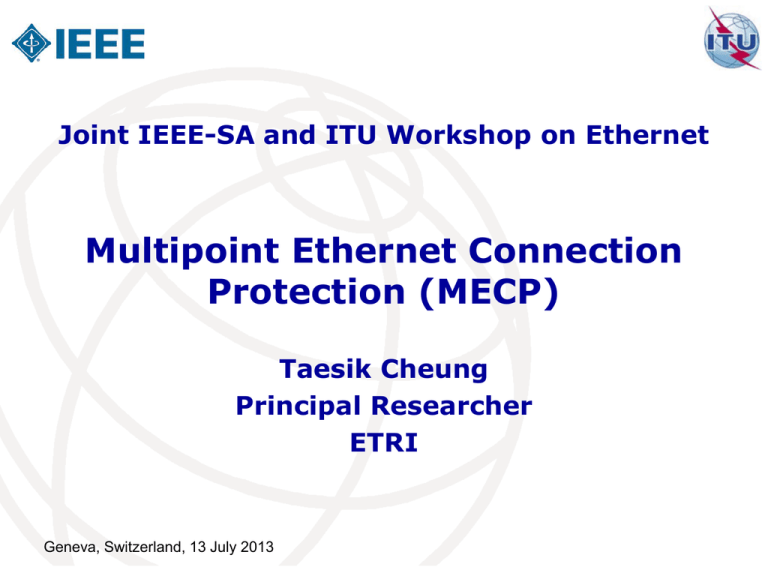Multipoint Ethernet Connection Protection (MECP) Joint IEEE-SA and ITU Workshop on Ethernet
advertisement

Joint IEEE-SA and ITU Workshop on Ethernet Multipoint Ethernet Connection Protection (MECP) Taesik Cheung Principal Researcher ETRI Geneva, Switzerland, 13 July 2013 MECP Overview MECP is a study point of Q9/WP3. Scope of MECP is to protect single rootedmultipoint (RMP) Ethernet connections in Ethernet transport networks. Contributions have been provided for a mechanism based on G.8031 APS protocol to support 1+1 and 1:1 protection Per-tree and per-leaf protection Geneva, Switzerland, 2 13 July 2013 2 Problem Statements G.8031 (APS) or G.8032 (R-APS) can be used between root and each leaf node. Root node should process multiple (R)-APS instances. Root Leaf 1 In case of a failure affecting many leaf nodes, there may be a need for many (R)-APS instances to switch-over simultaneously. X Switch Leaf 2 Leaf 3 Root Leaf 1 Geneva, Switzerland, 2 13 July 2013 Switch Switch Switch Leaf 2 Leaf 3 n x APS instances Leaf n n x R-APS instances Leaf n 3 Use Cases of MECP MECP could be used to protect RMP connections in a tree network topology. Potential use cases: Mobile backhaul networks Administrative networks of provincial government (Connection between leaf nodes is not allowed.) PTS Working tree DU(1) Single MECP instance Aggr. Aggr. DU(2) DU(3) Protection tree DU(m) PTS: Packet Transport Switch, Aggr.: Aggregation switch, DU: Digital Unit Geneva, Switzerland, 2 13 July 2013 4 Per-tree Protection A working tree is protected by a dedicated protection tree. A single failure on the working tree which affects only a portion of the leaf nodes causes the whole traffic flowing on the working tree to be switched to the protection tree. Geneva, Switzerland, 2 13 July 2013 L1 Working tree L2 R Protection tree Working tree Lm X L1 L2 R Protection tree Lm 5 Per-leaf Protection A working tree is protected by a dedicated protection tree. In the event of a failure on the working tree, perleaf protection switches over the traffic that belongs to the affected leaf node. Geneva, Switzerland, 2 13 July 2013 L1 Working tree L2 R Protection tree Working tree Lm X L1 L2 R Protection tree Lm 6 A proposal to base MECP protocol on G.8031 West node East node B S Working P2P EC S APS B Protection P2P EC B: Bridge S: Selector APS NR(0,0) NR(0,0) SF(1,1) 1-phase APS Protocol SF detected on working path Set bridge/selector to protection path Send request Accept request NR(1,1) Geneva, Switzerland, 2 13 July 2013 Set bridge/selector to protection path Send confirmation 7 Per-tree protection architecture Root node Leaf node (1) B S S B APS(R) APS(L1) Geneva, Switzerland, 2 13 July 2013 S B Working RMP EC Root node has one bridge and one selector. Each leaf node has one bridge and one selector. Root node sends identical APS messages to all the leaf nodes. (using multicast DA) Each leaf node sends APS messages to the root node. Protection RMP EC Leaf node (2) APS(L2) Leaf node (m) S B APS(Lm) 8 Per-leaf protection architecture N W Root node P Selector bridge N W Leaf node (1) Wr B S W1~Wm S P1~Pm P Broadcast bridge APS(L1) Leaf node (2) S B Working RMP EC Protection RMP EC Root node has one broadcast bridge and multiple selectors. Each leaf node has one bridge and one selector. Root node sends different APS messages to each leaf nodes. (using unicast DA) Each leaf node sends APS messages to the root node. B Pr APS(R) APS(L2) Leaf node (m) S B APS(Lm) Wr: Working tree (root all leaves) Wm: Working path (leaf m root) Pr: Protection tree (root all leaves) Pm: Protection path (leaf m root) Geneva, Switzerland, 2 13 July 2013 9 Issues under discussion Architecture and mechanism for per-leaf protection Consideration on various triggers for per-tree protection Benefits of per-tree protection comparing with per-leaf protection Monitoring methods for working/protection tree Trade-off in terms of processing/management of per-tree protection vs. using N APS/R-APS processes Geneva, Switzerland, 2 13 July 2013 10



